Renal haemodynamic responses to exogenous and endogenous adenosine in conscious dogs
- PMID: 9625888
- PMCID: PMC2231014
- DOI: 10.1111/j.1469-7793.1998.321bz.x
Renal haemodynamic responses to exogenous and endogenous adenosine in conscious dogs
Abstract
1. Adenosine has been suggested to be the mediator of a metabolic feedback mechanism which transfers acute changes in the tubular load into opposite changes in renal blood flow (RBF). The goal of the present experiments was to assess the importance of endogenously formed adenosine as a 'homeostatic metabolite' during short-term changes in metabolic demand. 2. In nine chronically instrumented conscious foxhounds, both the direct effects of adenosine injections (10, 30 and 100 nmol) into the renal artery and the temporal changes of RBF after short renal artery occlusions (15, 30 and 60 s duration), the most widely used experimental model to study the metabolic feedback mechanism in vivo, were studied. 3. Intrarenal bolus injections of adenosine (10, 30 and 100 nmol) induced dose-dependent decreases of RBF (RBF: -34 +/- 5, -59 +/- 4 and -74 +/- 4 %, respectively). This vasoconstrictor effect of adenosine was significantly larger (RBF: -51 +/- 4, -68 +/- 4 and -83 +/- 3 %, respectively) when the dogs received a low salt diet. 4. The post-occlusive responses were characterized by a transient hyperaemia with no detectable drop of RBF below the preocclusion level. The post-occlusive responses were affected neither by changes in local angiotensin II levels, nor by intrarenal infusions of hypertonic NaCl or blockade of A1 adenosine receptors. 5. When intrarenal adenosine levels were elevated by infusion of the adenosine uptake inhibitor dipyridamole, a transient, although weak, post-occlusive vasoconstriction was detected. 6. In summary, the present data demonstrate that adenosine acts as a potent renal vasoconstrictor in the conscious dog. The endogenous production of adenosine during short-lasting occlusions of the renal artery, however, appears to be too small to induce a post-occlusive vasoconstrictor response of RBF. These results suggest that a metabolic feedback with adenosine as 'homeostatic metabolite' is of minor importance in the short-term regulation of RBF in the conscious, unstressed animal.
Figures
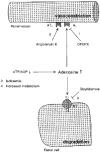
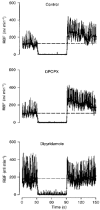

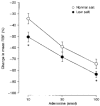
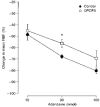
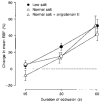
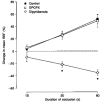
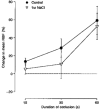
Similar articles
-
Interaction between angiotensin II and adenosine in mediating the vasoconstrictor response to intrarenal hypertonic saline infusions in the dog.J Pharmacol Exp Ther. 1990 Feb;252(2):631-5. J Pharmacol Exp Ther. 1990. PMID: 2179530
-
Inhibition of renal vasoconstriction induced by intrarenal hypertonic saline by the nonxanthine adenosine antagonist CGS 15943A.J Pharmacol Exp Ther. 1989 Mar;248(3):1123-9. J Pharmacol Exp Ther. 1989. PMID: 2703965
-
Aminophylline inhibits renal vasoconstriction produced by intrarenal hypertonic saline.J Pharmacol Exp Ther. 1983 Jun;225(3):611-5. J Pharmacol Exp Ther. 1983. PMID: 6864522
-
Renal hemodynamic and tubular effects of angiotensins II and III.Chin J Physiol. 1991;34(1):121-38. Chin J Physiol. 1991. PMID: 1874031 Review.
-
Modulation of renal microvascular function by adenosine.Am J Physiol Regul Integr Comp Physiol. 2003 Jul;285(1):R23-5. doi: 10.1152/ajpregu.00181.2003. Am J Physiol Regul Integr Comp Physiol. 2003. PMID: 12793988 Review. No abstract available.
Cited by
-
Afferent arteriolar vasodilator effect of adenosine predominantly involves adenosine A2B receptor activation.Am J Physiol Renal Physiol. 2010 Aug;299(2):F310-5. doi: 10.1152/ajprenal.00149.2010. Epub 2010 May 12. Am J Physiol Renal Physiol. 2010. PMID: 20462966 Free PMC article.
-
Failure to upregulate the adenosine2A receptor-epoxyeicosatrienoic acid pathway contributes to the development of hypertension in Dahl salt-sensitive rats.Am J Physiol Renal Physiol. 2008 Dec;295(6):F1696-704. doi: 10.1152/ajprenal.90502.2008. Epub 2008 Oct 1. Am J Physiol Renal Physiol. 2008. PMID: 18829737 Free PMC article.
References
-
- Agmon Y, Dinour D, Brezis M. Disparate effects of adenosine A1- and A2-receptor agonists on intrarenal blood flow. American Journal of Physiology. 1993;265:F802–806. - PubMed
-
- Arend LJ, Thompson CI, Spielman WS. Dipyridamole decreases glomerular filtration in the sodium-depleted dog. Circulation Research. 1985;56:242–251. - PubMed
-
- Barrett RJ, Droppleman DA. Interactions of adenosine A1 receptor-mediated renal vasoconstriction with endogenous nitric oxide and ANG II. American Journal of Physiology. 1993;265:F651–659. - PubMed
-
- Carmines P, Inscho EW. Renal arteriolar angiotensin responses during varied adenosine receptor activation. Hypertension. 1994;23(supp. I):I114–119. - PubMed
-
- Dietrich MS, Endlich K, Parekh N, Steinhausen M. Interaction between adenosine and angiotensin II in renal microcirculation. Microvascular Research. 1991;41:275–288. 10.1016/0026-2862(91)90028-A. - DOI - PubMed
Publication types
MeSH terms
Substances
LinkOut - more resources
Full Text Sources

